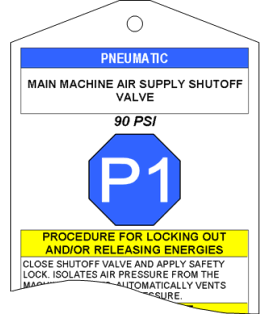Home » Lockout Resources » Energy Source Reference » Pneumatic Energy Sources
Pneumatic Energy Sources

Definition of Pneumatic Energy
Pneumatic energy pertains to the power related to pressurized air. The pressure can be relatively static (such as surge tanks or pressure tanks) or in motion through tubing or hoses. A good percentage of industrial equipment subject to OSHA 1910.147 will have at least one pneumatic Energy Source. To do useful work, industrial equipment often converts pneumatic energy into other forms of kinetic or Potential Energy.
Associated Pneumatic Energy Hazards
Per OSHA, there are hundreds of injuries annually due to improper handling of Pneumatic energy.
Injuries associated with Pneumatic energy generally consist of the following:
- Eye injuries due to released pressure or blown debris.
- Skin abrasions/punctures when exposed to high pressure fluid stream.
- Unexpected machine motion due to Pneumatic pressure acting on machine components. Such actions could result in lacerations, pinching, crushing, or amputation.
Proper Lockout/Tagout can virtually eliminate the risk involved with Pneumatic energy.
Means of Pneumatic Energy Isolation
Pneumatic energy must be controlled via a mechanical energy isolating device that physically prevents the transmission or release of energy. Some pneumatic isolation devices automatically vent air pressure when lock out occurs, others require manual venting. Details about handling stored pneumatic energy are available at the Stored Pneumatic Energy page.
Verifying Absence of Pneumatic Energy
Verifying the absence of pneumatic energy after performing Lockout/Tagout can be done by attempting to operate the associated components and by observing the associated gages to ensure they indicate 0 pressure.
Typical Pneumatic Energy Isolation Devices
Pneumatic energy isolation devices may vary in design and configuration. The following types are most common:
- Piston-type valves that stop air flow and vent the system
- Ball valves with venting feature
- Non-venting Gate or Ball valves
- Quick-Disconnect connectors
Typical Pneumatic Energy Lockout Devices
Pneumatic energy Lockout devices use positive means such as a lock and key to keep the associated energy isolation device in the safe position and prevent equipment energization. Typical pneumatic energy lockout devices are outlined in the Valve and Pneumatic page.
Lockout Services | Turnkey Programs | Lockout Procedures | Single-Source Procedures | Basic Procedures | Standard Procedures | Advanced Procedures | Custom Procedures | Energy Control Tags | Alternative Protective Measures | Minor Servicing Exception | Online Services | Lockout Audits | Corporate Standards | Lockout Training | Reference Guides | Services RFQ | DEenergizer | Lockout Devices | Electrical | Valve and Pneumatic | Accessories | Group Lockout/Tagout | Devices Index | Devices RFQ | Lockout Resources | OSHA Documentation | NIOSH Documentation | White Papers and Articles | Lockout/Tagout FAQ | Lockout/Tagout News | Lockout/Tagout Signs | Energy Source Reference | Training Material | Library | Glossary | Sitemap | About | Contact Information | Careers | Privacy Policy | Terms of Use | Legal Notice

